Alocasia Macrorrhizos, a tropical plant often referred to as giant taro, giant alocasia, or elephant ear plant, is known for its impressive size and striking foliage. It also happens to be a fantastically easy plant to care for indoors!
We’ll dive deep into the world of Alocasia Macrorrhiza care, introducing you to its fascinating features and what makes it a must-have addition to your indoor garden. We’ll also share valuable tips and tricks on how to lovingly care for and maintain this tropical beauty, ensuring it thrives throughout the seasons.
Table of Contents
Alocasia Macrorrhizos Plant Care Guide
History, Habitat, and Characteristics
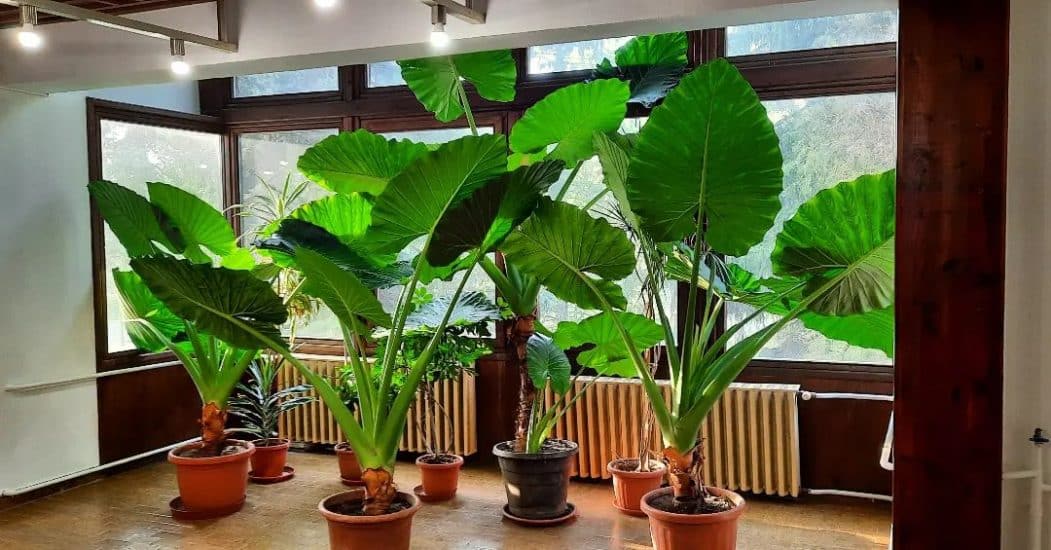
Alocasia Macrorrhiza is more than just a pretty plant. Native to Southeast Asian countries like the Philippines, Malaysia, and Indonesia, Alocasia Macrorrhizos’ appeal has spread far beyond its roots, with growth documented even in Palermo, Italy.
Speaking of roots, the Alocasia Macrorrhiza (giant taro), has a unique growth structure. It grows from a rhizome, which is an underground stem that stretches out horizontally.
Size is a distinction of the giant taro — it’s no wallflower. With large, heart-shaped leaves and reaching heights just as tall as a person, this plant is the reason “elephant ears” is a term you’ll never forget.
In its natural habitat, Alocasia Macrorrhiza thrives alongside moving water. Its lush, green foliage will have you daydreaming of riverside retreats. But be mindful, variegated varieties can be more sensitive, requiring a gentle touch of extra care.
Did you know: Alocasia Macrorrhiza rhizomes can be cooked to produce an edible root vegetable called taro. They must be cooked first to remove toxic calcium oxalate crystals. Taro have been harvested for years as a substitute for potatoes in tropical places where potatoes can’t grow.
Light
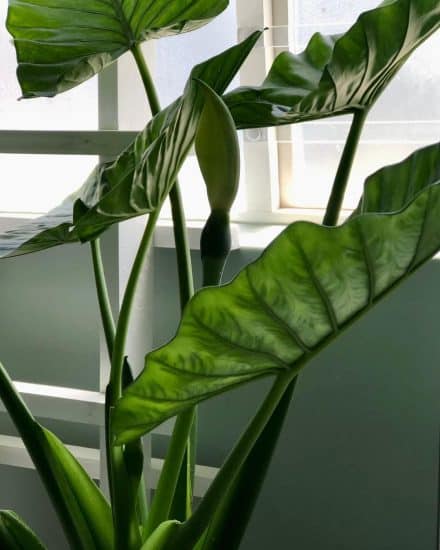
Alocasia Macrorrhiza thrives under full sun and even does exceptionally well in greenhouses without any shade. However, when grown outdoors in sunnier climates, some shade in a sheltered location is advisable, like a shade garden.
Position your plant near a window with bright indirect light, avoiding harsher direct light. For those with variegated varieties, it’s best to keep them in partial shade, particularly if they have fewer leaves.
If the plant isn’t getting enough light, you may notice slow and leggy growth, along with dull or pale-looking green leaves. Conversely, an overabundance of light can lead to scorched or yellowed leaves.
Our lighting tips:
- Place your Alocasia Macrorrhiza near a window with bright light but not direct sunlight.
- Keep variegated varieties in partial shade, particularly if they have fewer leaves.
- Be on the lookout for inadequate light, signaled by slow, leggy growth and pale green leaves.
- If your plant is showing signs of too much light, adjust its location or add a bit of shade.
- To encourage faster growth and healthy foliage, consider using artificial light sources (preferably LED, full spectrum), especially if morning or evening sun exposure isn’t possible.
Water
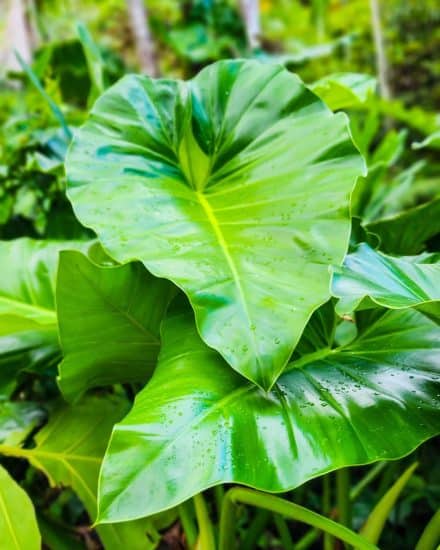
When your Alocasia Macrorrhiza isn’t getting the water it needs, you’ll see wilted, brown-tipped, or curling leaves and a weak root system. The soil will be dry and loose, leading to poor moisture absorption. To help your plant thrive, adjust your watering schedule so that the soil remains consistently moist.
On the other hand, overwatering can result in yellowing leaves and mushy stems. If brown leaf tips are followed by small brown and black spots, the likely culprit is root rot or fungal diseases like Southern blight or leaf spot disease. In this case, reduce your watering frequency and let the soil dry out before the next watering session.
Adjust your watering frequency during dormancy periods or when moving your plant to a darker location for the winter months.
Our tips:
- Keep the soil of your giant taro consistently moist by watering it with lukewarm water once or twice a day.
- Proper drainage is key to preventing waterlogged soil and root rot, so prioritize a pot with a drainage hole and a soil mix that drains well, like peat moss mixed with orchid bark.
- Variegated Alocasia species need less water, especially if they have only a few leaves. Adjust your watering routine accordingly.
- Monitor your plant for signs of underwatering (wilting, curling, brown leaves) and overwatering (yellowing leaves, mushy stems, wet soil, stunted growth), and tweak your watering schedule as needed.
Temperature and Humidity
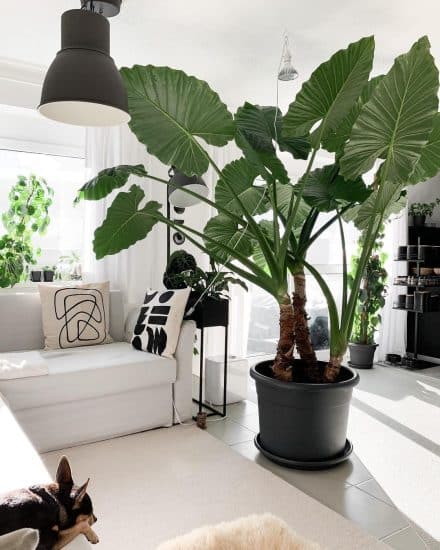
Temperature plays a significant role in the health and growth of your Alocasia Macrorrhiza. The Royal Horticultural Society (RHS) recommends a winter temperature minimum of 50-59°F (10-15°C). During other seasons, though, Alocasia plants thrive at around 86°F (30°C).
Keep an eye out for leaves that begin to yellow or droop, as this might signal that the temperature is not within the ideal range.
When it comes to humidity, Alocasia Macrorrhiza loves humid environments. And that makes sense, since its native climate in Malaysia has a high humidity level of approximately 80%!
If the edges of the leaves start to curl or crisp, this may be a sign that there’s not enough humidity. On the other hand, brown or black spots on the leaves or a mushy texture might indicate too much humidity.
Our humidity tips:
- Set your Alocasia macrorrhizos on a tray filled with pebbles and water to increase the surrounding humidity.
- Group your Alocasia with other humidity-loving plants, so they share moisture through a process called transpiration.
- Use a humidifier in the room where your Alocasia lives to help maintain an adequate humidity level.
- Regularly mist the area around your plant with lukewarm water, but avoid directly spraying the leaves, as this could cause additional issues.
Soil and Planting
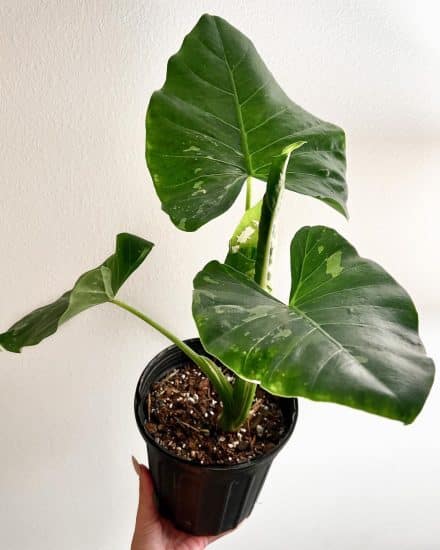
Let’s explore the ideal soil composition for your Alocasia Macrorrhiza to thrive.
- Regular potting soil. Provides essential nutrients and helps retain moisture.
- Bark. Improves drainage and prevents waterlogged soil.
- Horticultural sand. Enhances drainage and aeration, promoting healthy root development.
Ensure about a quarter of the overall volume of the mix consists of well-drained inorganic and bark materials. These ingredients, along with proper drainage holes, will create a balanced soil for your healthy plant to make its home.
Consider repotting your Alocasia every two months into slightly larger pots (about 1-2 inches bigger).
Fertilizer
Feed your Alocasia Macrorrhiza a balanced liquid fertilizer every six to eight weeks during the growing season. You’ll want to dilute it to 50% of its strength.
Over-fertilization can cause burnt leaves and stunted growth. If you notice yellowing leaves or a white crust on the soil surface, flush the soil with water to eliminate excess fertilizer.
Propagation
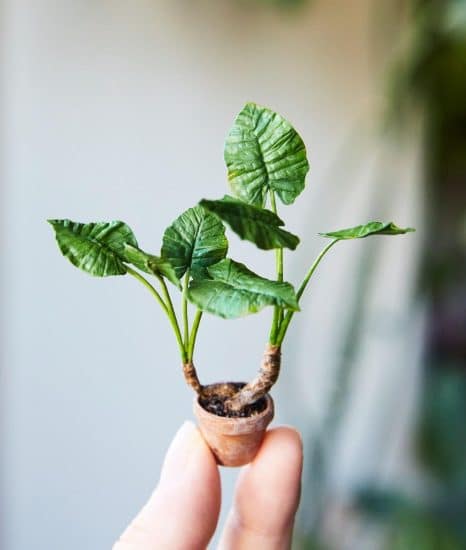
Propagating Alocasia Macrorrhiza, also known as the giant taro, is an exciting way to expand your collection or share these stunning tropical plants with friends and family.
Since Alocasia Macrorrhiza grows from a rhizome, you can’t really propagate it with stem cuttings. But using rhizome division, you’ll be able to achieve new growth in a few simple steps.
Propagating Alocasia Macrorrhiza through rhizome division:
- Gather your materials: You’ll need a clean pair of sharp gardening shears, a small pot with drainage holes, a soil mix that drains well, and a container or plastic bag to keep humidity high for your cutting. Make sure the mother plant is healthy and has a strong root system with several rhizomes.
- Gently remove the plant from its pot: Carefully take the Alocasia Macrorrhiza out of its current pot, being cautious not to damage the root system. Place the plant on a clean, flat surface so you can access the rhizomes more easily.
- Find and cut the rhizome: Take a look at the root system to spot a healthy rhizome with at least one growth point, and maybe some small offshoots. Use your clean, sharp gardening shears to cut a piece of the rhizome off of the main plant. Remember not to detach any albino offshoots from variegated varieties, as they won’t survive independently.
- Plant the rhizome cutting: Fill the small pot with the potting medium, such as a mix of peat moss and potting soil, and make a hole in the center. Place the rhizome cutting into the hole, making sure the growth point faces up. Gently cover the rhizome with soil mix, but avoid compacting the soil too much, since this might obstruct root development.
- Provide warmth, moisture, and indirect light: Water the rhizome cutting with lukewarm water, and cover the pot with a plastic container or bag to create a humid environment. Put the pot in a warm, bright area to encourage growth. Ensure proper water retention by keeping the potting mix consistently moist, but not soggy.
- Keep an eye on new growth: In about two weeks, you should see new growth sprouting from the rhizome cutting. Once the new growth is progressing well, reduce humidity by removing the plastic container or bag. Continue caring for your new Alocasia Macrorrhiza plant as you normally would.
Our propagation tips:
- Ensure your gardening shears are clean and sharp to prevent infections and achieve a clean cut.
- Select a healthy rhizome with a visible growth point to improve your chances of successful propagation.
- Consistently monitor the moisture level of the potting mix during the propagation process. Both too much and too little water can hinder growth.
Common Issues
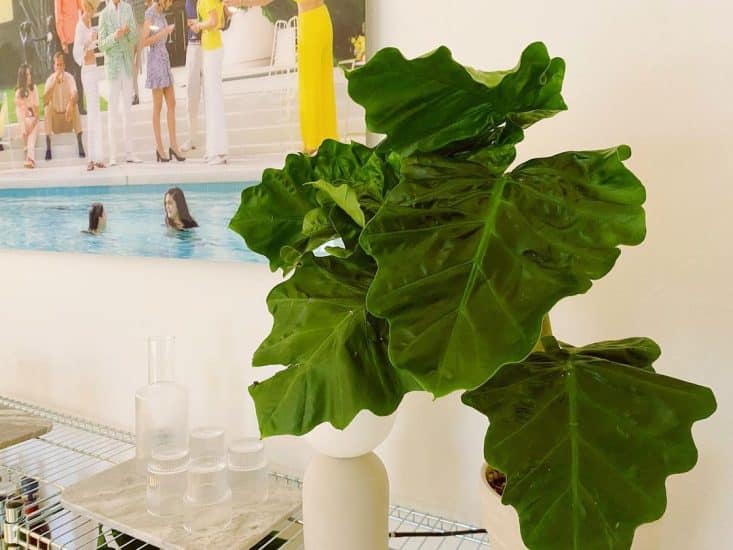
Alocasia macrorrhiza, also known as giant elephant ears or giant taro, is a resilient and easy-going species of the Alocasia genus, but can still experience some common issues.
Yellowing Leaves
Sometimes Alocasia macrorrhizos plants develop yellow leaves, a symptom that could emerge from multiple causes: inadequate watering, energy conservation for new growth, or using too cold water.
If the yellowing occurs suddenly and within a week, don’t worry — this doesn’t necessarily mean you’re dealing with dying leaves. Just keep providing proper plant care and monitor your plant. To prevent yellowing from insufficient hydration, remember to water your plant when the top inch or two of the soil surface feels dry to the touch. Also, use a well-draining potting medium to avoid waterlogged roots.
Brown Leaf Edges
Brown leaf edges on your Alocasia macrorrhizos plant signal different potential problems, such as underwatering, overwatering, or low humidity. To pinpoint the issue, start by examining the soil’s moisture levels and adjust your watering habits accordingly.
If humidity is the culprit, increase it around your plant by either misting daily (avoiding the leaves directly) or placing it on a tray of damp pebbles.
(Note that while misting won’t necessarily help raise humidity in the long-term, if you wipe off the moisture afterward, it does help remove dust particles that tend to gather on this plant’s large leaves and interfere with your plant’s light capturing efficiency, or photosynthesis).
Keep in mind that when repotting your Alocasia macrorrhiza, it’s essential to position the plant flat in the pot with ample space in front of the largest part of the plant. Press down the potting soil to eliminate air pockets to help create a healthy environment for your plant to flourish.
Pests and Diseases
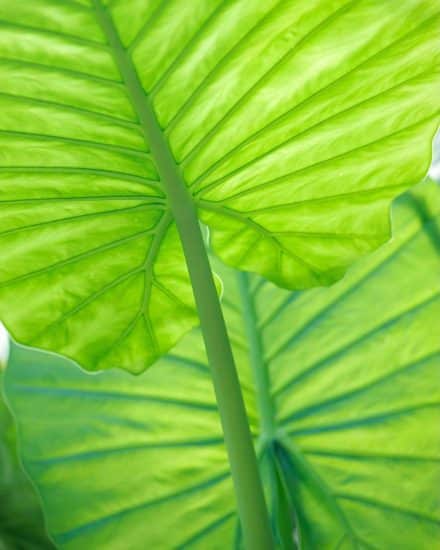
Pests
Alocasia macrorrhiza pests can include mealybugs, scales, aphids, and spider mites. These tiny troublemakers can damage your precious plant and could spread to your other houseplants if not addressed in time. Act immediately if you see signs of infestation.
To combat spider mites and other pests, simply mix a few drops of dish soap with cold water and spray it onto the affected areas; the soapy solution helps dissolve the pests’ protective coatings. Afterward, gently wipe the solution off with a soft cloth or rinse it away with water.
Stay vigilant, as you might need to repeat the treatment to eliminate the pests and their eggs.
Root Rot
Just like many indoor houseplants, those in the Alocasia species may experience root rot. When Alocasia Macrorrhiza receives too much water or has poor soil drainage, it becomes a perfect environment for harmful fungi to grow. Consequently, the roots turn mushy and black, which could be detrimental to the plant’s survival.
To prevent root rot, always make sure your Alocasia is potted in a well-draining potting medium and avoid excessive watering. The key is to only water your plant when the top inch of the soil feels dry.
If you think your Alocasia has root rot, remove it from the pot and inspect its roots. With a sterilized cutting tool, cut away any roots that appear mushy or discolored. Then, repot your Alocasia in fresh, well-draining soil and a clean pot. In the future, consider using a moisture meter to maintain the right soil moisture level.
Conclusion
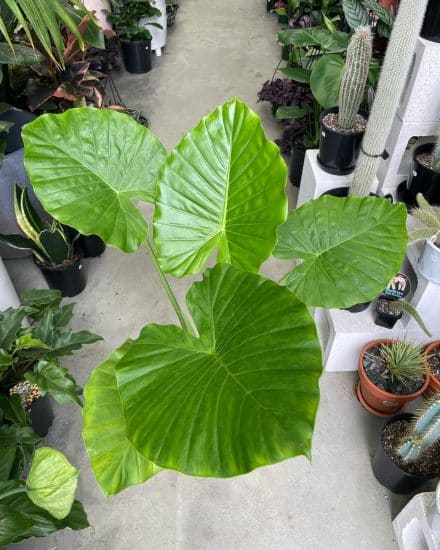
That’s a wrap for our Alocasia macrorrhizos care guide!
This stunning giant taro plant is a real conversation starter, and it adds an exotic and impressive touch to your indoor garden.
Alocasia macrorrhizos care summary:
- These plants thrive in bright, indirect light (never direct sunlight!) while variegated varieties prefer more shade.
- Maintain consistently moist soil, adjusting your watering schedule to meet the specific needs of your plant.
- Aim for a humidity level of around 80% for optimal growth in this humidity-loving plant.
- Ensure a minimum winter temperature of 50-59°F (10-15°C) and a warmer 86°F (30°C) during other seasons.
- Propagate via rhizome division to facilitate new growth and to share this beautiful plant with friends and family.
We hope this guide helps you feel confident about growing Alocasia Macrorrhiza in your own home. Feel free to share this guide with fellow plant lovers! If have any questions, please don’t hesitate to reach out to us.
Take care, and happy planting!
FAQ
Is Alocasia Macrorrhizos an indoor plant?
Absolutely! Alocasia Macrorrhizos can be successfully grown as an indoor plant, provided you pay attention to the plant’s temperature and humidity requirements.
Keep your Alocasia in a bright, warm spot with indirect sunlight, and ensure the humidity levels are consistently within the ideal range (around 80%). If necessary, use a humidifier or a tray of water near the plant to maintain the desired humidity.
How big does Alocasia Macrorrhizos get?
Alocasia Macrorrhizos, also known as the giant taro, can grow quite large, with some reaching heights of up to 15 feet (4.5 meters) in their native environment. However, when grown indoors, they generally reach a more modest size of around 4 to 6 feet (1.2 to 1.8 meters) tall. With their large, glossy leaves, these plants can be a stunning focal point in your home.
Is Alocasia Macrorrhizos rare?
While Alocasia Macrorrhizos is not an extremely rare plant, it is considered a less common houseplant compared to other varieties, like the popular Alocasia amazonica ‘Polly’ or Alocasia zebrina. Alocasia Macrorrhizos brings its own unique beauty to your indoor plant collection, with its distinctively large leaves and strong, upright growth habit.
Is Alocasia Alocasia Macrorrhizos the same as giant taro?
Yes, Alocasia Macrorrhizos is also known by the common name, giant taro, thanks to its impressive size and growth potential. The term “taro” is sometimes used to describe the entire Alocasia genus, so don’t get confused with other similar plants like Colocasia esculenta, which is also called taro.
Is Alocasia Macrorrhizos toxic?
Alocasia Macrorrhizos, like many other Alocasia varieties, contains calcium oxalate crystals, which can be toxic if ingested. It’s crucial to keep these plants out of reach of curious pets and young children.


